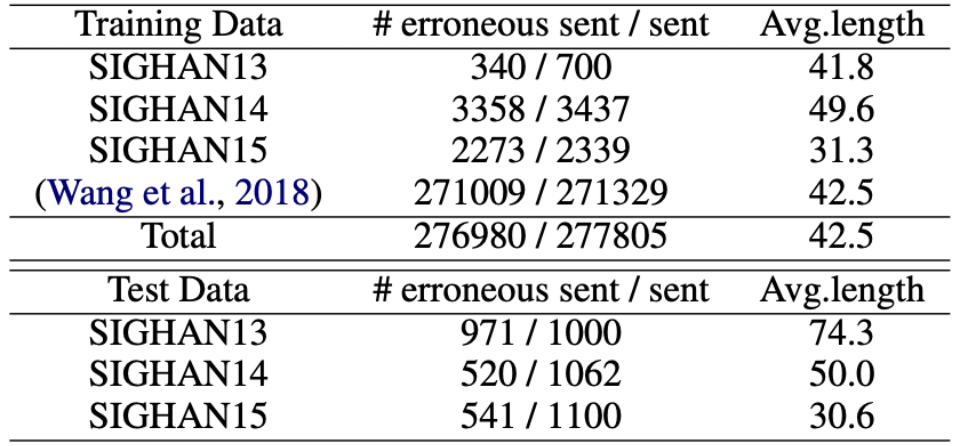中文拼写检测(Chinese Spelling Checking)相关方法、评测任务、榜单
中文拼写检测(Chinese Spelling Checking,CSC)是近两年来比较火的小众任务,在包括ACL、EMNLP等顶会上发展迅速。本文简单介绍CSC任务,相关方法、评测任务和榜单。
一、中文拼写检测
中文拼写检测(Chinese Spelling Checking,CSC)又称中文拼写纠错(Chinese Spelling Correction,CSC),其旨在根据上下文来识别并纠正错误的拼写问题,起源于英文的拼写检测和语法错误识别问题。由于近年来中文NLP的发展加速,包括中文文本挖掘、中文预训练语言模型等,诸多中文语料或垂直领域语料中都会存在的一些拼写错误问题,因此提升语料质量十分重要。
目前中文拼写检测常用在如下三个场景中:
- OCR识别:是指对图像类型的文字通过CV算法转换为UTF-8的字符。但是由于OCR属于单字独立识别,可能由于图像模糊、遮盖等问题导致识别出错,因此OCR识别出的文本可能会存在拼写错误问题。一般地,OCR属于视觉特征方面的文字识别任务,因此拼写错误通常来源于相似字形混淆。
例如“金属材料”可能会被错误识别为“金属材科”,因为“科”与“料”在字形上非常相似。
- ASR识别:是指根据语音来转换为文字,属于语音识别。通常也会因为杂音、方言等问题,部分音节存在相似混淆而导致识别错误。
例如“星星产业”与“新兴产业”,“星星”与“新星”如果在说话者咬字不清晰的情况下是很难区分的。
- 意外错误:例如工作人员在键入信息时,可能由于敲错键盘等马虎行为,导致输入了错误的字符。
例如在输入“伤感”(shanggan)时,可能会误输入为“伤寒”(shanghan),因为“g”和“h”在键盘布局内仅靠在一起;
但是最终我们期望识别的文本在上下文是存在语义的,由于一些错误的拼写,我们依然可以判断他原始的正确字符。例如即便OCR错误识别为“金属材科”,我们依然可以根据上下文与先验知识来推测应为“金属材料”。当然也有可能是由于不同领域的问题,使得这个纠错任务并非完全依靠上下文。例如常见的搭配是“新兴产业”,但是不得排除“星星产业”是某一个商标或特定领域专有词汇。
因此,学术界引入中文拼写检测(CSC)来专门也就如何识别并纠错。在数据的构建上,可以直接根据混淆集来生成错误字符,而混淆集的构建则需要专门处理,如下图所示,可以针对对图像进行模糊化处理来生成错误的字符:

下面给出CSC基础概念:
- 混淆集(Confusion Set):是指一系列存在字音字形相似的字符集合,例如“自”与“白”、“曰”存在字形混淆。在预测时,通常根据混淆集来召回可能的字符,再根据上下文预测正确的字符;
- 字形特征(Glyphic Feature):通常表示一个汉字的偏旁部首(结构特征)和笔画序列(序列特征),例如:“争”的结构特征可以描述为“⿱⿰⿻⿻⿱”,序列特征为“丿㇇????一一亅”
偏旁部首和笔画通常也可以描述为树形结构,如图所示:
- 字音特征(Phonetic Feature):通常表示一个字符的拼音(pinyin),例如“天”的pinyin序列为“tian1”,“盛”的pinyin序列可能为“sheng4”、“cheng2”(其中数字部分表示声调)。在特征提取时,通常可以将pinyin单独作为一个特征,或将pinyin作为一个序列进行处理。
二、相关方法
本部分简单列出最近相关论文(会不定时更新,如有最新稿件,可在评论区提供),如下所示:
【1】DCSpell:A Detector-Corrector Framework for Chinese Spelling Error Correction(SIGIR2021)
【2】Tail-to-Tail Non-Autoregressive Sequence Prediction for Chinese Grammatical Error Correction(ACL2021)
【3】Correcting Chinese Spelling Errors with Phonetic Pre-training(ACL2021)
【4】PLOME:Pre-trained with Misspelled Knowledge for Chinese Spelling Correction(ACL2021)
【5】PHMOSpell:Phonological and Morphological Knowledge Guided Chinese Spelling Check(ACL2021)
【6】Exploration and Exploitation: Two Ways to Improve Chinese Spelling Correction Models(ACL2021)
【7】Dynamic Connected Networks for Chinese Spelling Check(2021ACL)
【8】Global Attention Decoder for Chinese Spelling Error Correction(ACL2021)
【9】Read, Listen, and See: Leveraging Multimodal Information Helps Chinese Spell Checking(ACL2021)
【10】SpellBERT: A Lightweight Pretrained Model for Chinese Spelling Check(EMNLP2021)
【11】A Hybrid Approach to Automatic Corpus Generation for Chinese Spelling Check(EMNLP2018)
【12】Adversarial Semantic Decoupling for Recognizing Open-Vocabulary Slots(EMNLP2020)
【13】Chunk-based Chinese Spelling Check with Global Optimization(EMNLP2020)
【14】Confusionset-guided Pointer Networks for Chinese Spelling Check(ACL2019)
【15】Context-Sensitive Malicious Spelling Error Correction(WWW2019)
【16】FASPell: A Fast, Adaptable, Simple, Powerful Chinese Spell Checker Based On DAE-Decoder Paradigm (2019ACL)
【17】SpellGCN:Incorporating Phonological and Visual Similarities into Language Models for Chinese Spelling Check (2020ACL)
【18】Spelling Error Correction with Soft-Masked BERT(ACL2020)
在OpenReview上提交至ARR2022的相关稿件有:
【1】Exploring and Adapting Chinese GPT to Pinyin Input Method 【PDF】
【2】The Past Mistake is the Future Wisdom: Error-driven Contrastive Probability Optimization for Chinese Spell Checking 【PDF】【Code】【Data】
【3】Sparsity Regularization for Chinese Spelling Check【PDF】
【4】Pre-Training with Syntactic Structure Prediction for Chinese Semantic Error Recognition【PDF】
【5】ECSpellUD: Zero-shot Domain Adaptive Chinese Spelling Check with User Dictionary【PDF】
【6】SpelLM: Augmenting Chinese Spell Check Using Input Salience【PDF】【Code】【Data】
【7】Pinyin-bert: A new solution to Chinese pinyin to character conversion task【PDF】
简单总结一下目前CSC的方法:
- 基于BERT:以为CSC时是基于token(字符)级别的预测任务,输入输出序列长度一致,因此非常类似预训练语言模型的Masked Language Modeling(MLM),因此现如今绝大多数的方法是基于MLM实现的。而在BERT问世前,CSC则以RNN+Decoder、CRF为主;
- 多模态融合:上文提到CSC涉及到字音字形,因此有一些方法则是考虑如何将Word Embedding、Glyphic Embedding和Phonetic Embedding进行结合,因此涌现出一些多模态方法;
三、评测任务
CSC常用的三个评测数据分别如下:
- SIGHAN Bake-off 2013: http://ir.itc.ntnu.edu.tw/lre/sighan7csc.html
- SIGHAN Bake-off 2014: http://ir.itc.ntnu.edu.tw/lre/clp14csc.html
- SIGHAN Bake-off 2015: http://ir.itc.ntnu.edu.tw/lre/sighan8csc.html
现如今大多数的CSC方法均涉及到预训练环节,常用的预训练语料为
- Wang271K: https://github.com/wdimmy/Automatic-Corpus-Generation
评测数据和训练语料的数据分布情况如图所示:

具体的实验细节可以总结如下:
(1)Pre-training语料
语料:nlp_chinese_corpus,随机挑选1M训练,max_len=128,batch_size=1024,lr=5e-5,step=10K。
获取《A Hybrid Approach to Automatic Corpus Generation for Chinese Spelling Check》构建的271K语料
(2)fine-tuning语料
SIGHAN13、SIGHAN14、SIGHAN15
直接使用SpellGCN提供的数据,其中:
● merged:表示SIGHAN13、SIGHAN14和SIGHAN15混合训练集(10K):
● SIGHAN13、SIGHAN14、SIGHAN15:分别表示测试集
OCR
使用《FASPell: A Fast, Adaptable, Simple, Powerful Chinese Spell Checker Based On DAE-Decoder Paradigm》构建的数据集:FASPell,总共4575句子
(3)评测脚本:详见本文末
四、榜单
博主简单列出了常用的评测任务上的榜单(实时更新),如下表:
SIGHAN13:https://www.yuque.com/wangjianing-jrsey/aagb95/vw4c3o?inner=XxC0h
SIGHAN14:https://www.yuque.com/wangjianing-jrsey/aagb95/vw4c3o?inner=nBQFV
SIGHAN15:https://www.yuque.com/wangjianing-jrsey/aagb95/vw4c3o?inner=yce4c
五、评测脚本
CSC常采用P、R、F1值进行评测,评测涉及到detection和correction两个层面,具体详见代码:
1
2
3
4
5
6
7
8
9
10
11
12
13
14
15
16
17
18
19
20
21
22
23
24
25
26
27
28
29
30
31
32
33
34
35
36
37
38
39
40
41
42
43
44
45
46
47
48
49
50
51
52
53
54
55
56
57
58
59
60
61
62
63
64
65
66
67
68
69
70
71
72
73
74
75
76
77
78
79
80
81
82
83
84
85
86
87
88
89
90
91
92
93
94
95
96
97
98
99
100
101
102
103
104
105
106
107
108
109
110
111
112
113
114
115
116
117
118
119
120
121
122
123
124
125
126
127
128
129
130import os import sys def convert_from_myformat_to_sighan(input_path, output_path, pred_path, orig_path=None, spellgcn=False): with open(pred_path, "w") as labels_writer: with open(input_path, "r") as org_file, open(orig_path, "r") as id_f: with open(output_path, "r") as test_file: test_file = test_file.readlines() org_file = org_file.readlines() print(len(test_file), len(org_file)) assert len(test_file) == len(org_file) for k, (pred, inp, sid) in enumerate(zip(test_file, org_file, id_f)): if spellgcn: _, atl = inp.strip().split("t") atl = atl.split(" ")[1:] pred = pred.split(" ")[1:len(atl)+1] else: atl, _, _= inp.strip().split("t")[:3] atl = atl.split(" ") pred = pred.split(" ")[:len(atl)] output_list = [sid.split()[0]] for i, (pt, at) in enumerate(zip(pred[:], atl[:])): if at == "[SEP]" or at == '[PAD]': break # Post preprocess with unsupervised methods, #because unsup BERT always predict punchuation at 1st pos if i == 0: if pt == "。" or pt == ",": continue if pt.startswith("##"): pt = pt.lstrip("##") if at.startswith("##"): at = at.lstrip("##") if pt != at: output_list.append(str(i+1)) output_list.append(pt) if len(output_list) == 1: output_list.append("0") labels_writer.write(", ".join(output_list) + "n") def eval_spell(truth_path, pred_path, with_error=True): #Compute F1-score detect_TP, detect_FP, detect_FN = 0, 0, 0 correct_TP, correct_FP, correct_FN = 0, 0, 0 detect_sent_TP, sent_P, sent_N, correct_sent_TP = 0, 0, 0, 0 dc_TP, dc_FP, dc_FN = 0, 0, 0 for idx, (pred, actual) in enumerate(zip(open(pred_path, "r", encoding='utf-8'), open(truth_path, "r", encoding='utf-8') if with_error else open(truth_path, "r", encoding='utf-8'))): pred_tokens = pred.strip().split(" ") actual_tokens = actual.strip().split(" ") #assert pred_tokens[0] == actual_tokens[0] pred_tokens = pred_tokens[1:] actual_tokens = actual_tokens[1:] detect_actual_tokens = [int(actual_token.strip(",")) for i,actual_token in enumerate(actual_tokens) if i%2 ==0] correct_actual_tokens = [actual_token.strip(",") for i,actual_token in enumerate(actual_tokens) if i%2 ==1] detect_pred_tokens = [int(pred_token.strip(",")) for i,pred_token in enumerate(pred_tokens) if i%2 ==0] _correct_pred_tokens = [pred_token.strip(",") for i,pred_token in enumerate(pred_tokens) if i%2 ==1] # Postpreprocess for ACL2019 csc paper which only deal with last detect positions in test data. # If we wanna follow the ACL2019 csc paper, we should take the detect_pred_tokens to: max_detect_pred_tokens = detect_pred_tokens correct_pred_zip = zip(detect_pred_tokens, _correct_pred_tokens) correct_actual_zip = zip(detect_actual_tokens, correct_actual_tokens) if detect_pred_tokens[0] != 0: sent_P += 1 if sorted(correct_pred_zip) == sorted(correct_actual_zip): correct_sent_TP += 1 if detect_actual_tokens[0] != 0: if sorted(detect_actual_tokens) == sorted(detect_pred_tokens): detect_sent_TP += 1 sent_N += 1 if detect_actual_tokens[0]!=0: detect_TP += len(set(max_detect_pred_tokens) & set(detect_actual_tokens)) detect_FN += len(set(detect_actual_tokens) - set(max_detect_pred_tokens)) detect_FP += len(set(max_detect_pred_tokens) - set(detect_actual_tokens)) correct_pred_tokens = [] #Only check the correct postion's tokens for dpt, cpt in zip(detect_pred_tokens, _correct_pred_tokens): if dpt in detect_actual_tokens: correct_pred_tokens.append((dpt,cpt)) correct_TP += len(set(correct_pred_tokens) & set(zip(detect_actual_tokens,correct_actual_tokens))) correct_FP += len(set(correct_pred_tokens) - set(zip(detect_actual_tokens,correct_actual_tokens))) correct_FN += len(set(zip(detect_actual_tokens,correct_actual_tokens)) - set(correct_pred_tokens)) # Caluate the correction level which depend on predictive detection of BERT dc_pred_tokens = zip(detect_pred_tokens, _correct_pred_tokens) dc_actual_tokens = zip(detect_actual_tokens, correct_actual_tokens) dc_TP += len(set(dc_pred_tokens) & set(dc_actual_tokens)) dc_FP += len(set(dc_pred_tokens) - set(dc_actual_tokens)) dc_FN += len(set(dc_actual_tokens) - set(dc_pred_tokens)) detect_precision = detect_TP * 1.0 / (detect_TP + detect_FP) detect_recall = detect_TP * 1.0 / (detect_TP + detect_FN) detect_F1 = 2. * detect_precision * detect_recall/ ((detect_precision + detect_recall) + 1e-8) correct_precision = correct_TP * 1.0 / (correct_TP + correct_FP) correct_recall = correct_TP * 1.0 / (correct_TP + correct_FN) correct_F1 = 2. * correct_precision * correct_recall/ ((correct_precision + correct_recall) + 1e-8) dc_precision = dc_TP * 1.0 / (dc_TP + dc_FP + 1e-8) dc_recall = dc_TP * 1.0 / (dc_TP + dc_FN + 1e-8) dc_F1 = 2. * dc_precision * dc_recall/ (dc_precision + dc_recall + 1e-8) if with_error: #Token-level metrics print("detect_precision=%f, detect_recall=%f, detect_Fscore=%f" %(detect_precision, detect_recall, detect_F1)) print("correct_precision=%f, correct_recall=%f, correct_Fscore=%f" %(correct_precision, correct_recall, correct_F1)) print("dc_joint_precision=%f, dc_joint_recall=%f, dc_joint_Fscore=%f" %(dc_precision, dc_recall, dc_F1)) detect_sent_precision = detect_sent_TP * 1.0 / (sent_P) detect_sent_recall = detect_sent_TP * 1.0 / (sent_N) detect_sent_F1 = 2. * detect_sent_precision * detect_sent_recall/ ((detect_sent_precision + detect_sent_recall) + 1e-8) correct_sent_precision = correct_sent_TP * 1.0 / (sent_P) correct_sent_recall = correct_sent_TP * 1.0 / (sent_N) correct_sent_F1 = 2. * correct_sent_precision * correct_sent_recall/ ((correct_sent_precision + correct_sent_recall) + 1e-8) if not with_error: #Sentence-level metrics print("detect_sent_precision=%f, detect_sent_recall=%f, detect_Fscore=%f" %(detect_sent_precision, detect_sent_recall, detect_sent_F1)) print("correct_sent_precision=%f, correct_sent_recall=%f, correct_Fscore=%f" %(correct_sent_precision, correct_sent_recall, correct_sent_F1)) if __name__ == '__main__': output_path = sys.argv[1] data_path = sys.argv[2] input_path = os.path.join(data_path, "test_format.txt") pred_path = os.path.join(os.path.dirname(output_path), 'pred_result.txt') orig_input_path = os.path.join(data_path, "TestInput.txt") orig_truth_path = os.path.join(data_path, "TestTruth.txt") convert_from_myformat_to_sighan(input_path, output_path, pred_path, orig_truth_path, spellgcn=False) eval_spell(orig_truth_path, pred_path, with_error=False)
最后
以上就是危机鸡最近收集整理的关于中文拼写检测(Chinese Spelling Checking)相关方法、评测任务、榜单中文拼写检测(Chinese Spelling Checking)相关方法、评测任务、榜单的全部内容,更多相关中文拼写检测(Chinese内容请搜索靠谱客的其他文章。









发表评论 取消回复